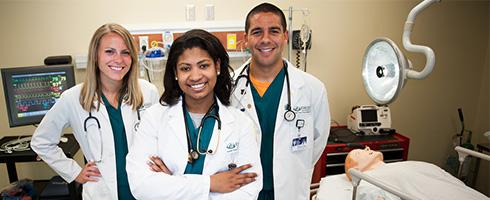Graduate Medical Education
The path toward becoming an osteopathic physician doesn’t end once a medical student receives a degree. Through the Heritage College’s many clinical partners, graduates pursue a host of residencies, from family medicine, pediatrics, emergency medicine and anesthesiology to surgery and obstetrics/gynecology, with an emphasis on primary care specialties.
The Heritage College supports ACGME-accredited residency programs through the Clinical Education Network. Recognizing that a strong GME learning environment influences the development of our medical students, the CEN strives to support and enhance the shared UME-GME clinical learning environment as a key strategy to assure the presence of strong training opportunities for medical students, residency partners and clinical faculty.
Ways We Connect with GME
- Graduate Medical Education Committee (GMEC) Participation
- GME Liaison Collaboration
- GME Program Development and Accreditation Support
- Osteopathic Integration and Recognition Support
- Medical Education Administrators and Managers (MEAM) Meetings
- Clinical Education Network Summits
- Clinician Educator Learning and Development Opportunities
- Resident Clinical Instructor Opportunity
- Newsletters and Communications
- Annual Match Reports for Clinical Education Network Partners
Needs Assessment
To help us define and resource the types of support our Ohio clinical education partners are seeking, we've developed a GME Support Needs Assessment to guide our process. The assessment focuses on three key areas of support: 1) New GME Development; 2) Existing GME Program Development and Support; and 3) Osteopathic Recognition. If you are looking to connect with the Heritage College in any of these key areas, please complete the needs assessment. We are eager to learn more!
Osteopathic Integration
The Heritage College's goals for osteopathic integration in graduate medical education include:
- Helping hospital residency programs successfully make the transition to ACGME residencies with osteopathic recognition.
- Promote faculty development in osteopathic principles and practices to residency faculty through a variety of educational opportunities.
- Promote resident development in osteopathic principles and practices through the creation and offering of educational modules designed to highlight specialty specific information for osteopathic integration.
For additional information or assistance with UME or GME osteopathic integration, contact osteopathic.integration@ohio.edu.
Residency Advising
The residency advising team assists students in specialty selection and navigating the residency application and match process. Their goal is to provide students with the necessary tools to thrive in their lifelong medical career.
The Match
The National Resident Matching Program® (NRMP®), also known as The Match®, is an independent, non-profit organization whose responsibility is to place the nation’s medical school talent into clinical training programs, ensuring a steady pipeline of highly qualified professionals are building the necessary skills to care for patients across the country. The Match is part of a larger transition in medical education that includes applying to and interviewing with training programs.
Learn more about The Matching Process.
Heritage College Match Data
Annually, the HCOM Office of Institutional Assessment and Accreditation publishes match results for graduating students. See where our most recent class matched into residency programs!
Accreditation and Osteopathic Recognition Resources
ACGME | Accreditation Council for Graduate Medical Education
The ACGME accredits Sponsoring Institutions and residency and fellowship programs, confers recognition on additional program formats or components, and dedicates resources to initiatives addressing areas of import in graduate medical education. The ACGME employs best practices, research, and advancements across the continuum of medical education to demonstrate its dedication to enhancing health care and graduate medical education.
Institution and Program Finder
Osteopathic Recognition (opens in a new window)
AOA | American Osteopathic Association
The AOA represents more than 197,000 osteopathic physicians and medical students across the U.S. The AOA advocates at the state and federal levels on issues that affect DOs, osteopathic medical students and patients and is committed to advancing the goal of increasing the number of programs with Osteopathic Recognition and offers resources to assist programs in the process.
AOA Osteopathic Recognition Support Tool
Osteopathic Recognition Checklist
AOA Resources for Osteopathic Recognition
AACOM | American Association of Colleges of Osteopathic Medicine
The American Association of Colleges of Osteopathic Medicine leads and advocates for the osteopathic medical education community to improve the health of the public. They support colleges of osteopathic medicine in their efforts to attract and train future physicians who are fueled by a desire to make a difference, to treat the whole person and build a future of health and wellness for all people.
Graduate Level Osteopathic Training
OOA | Ohio Osteopathic Association
The OOA is a divisional society of the American Osteopathic Association. The OOA advocates for all osteopathic physicians in the state, as well as medical students attending Ohio University Heritage College of Osteopathic Medicine (OU-HCOM) and several hospitals which are institutional members. The OOA works to ensure osteopathic medical students have access to ACGME residency programs with Osteopathic Recognition (OR).
